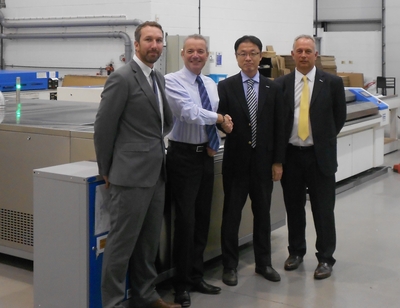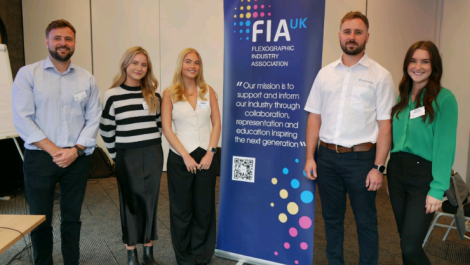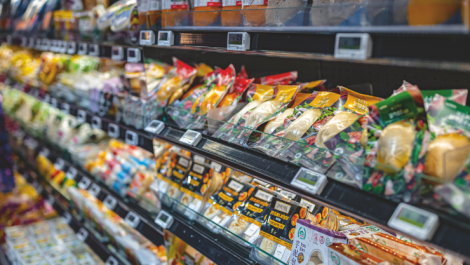David Parker, technical sales manager, and Mark Gration, group managing director, YRG Group, with Tatsuya Tajima, managing director of Asahi Photoproducts in Brussels, and Chris Lodge, Asahi Photoproducts (UK) Ltd
The process of turning a sheet or sleeve of photopolymers into a finished printing forme is a precise and tightly controlled science. How the dot is formed and its resulting shape varies greatly between the different technologies. By Neel Madsen.
The formation of the printing dot during plate or sleeve imaging and processing is vital to the end result, and the key word is control. Platemaking continues to evolve driven by market requirements of faster speeds, more environmentally sound solutions, higher print quality and lower costs.
Fifth anniversary Kodak’s Flexcel NX system has now been on the market for five years gathering a loyal following amongst platemakers. It relies on a high resolution mask material, the Thermal Imaging Layer (TIL), which is first imaged and then laminated to a photopolymer plate before UV exposure takes place.
The TIL can hold a 10 micron dot and reproduces exactly what is in the digital file. Nick Fisher, manager at Kodak’s UK flexo demo centre, said, ‘You can produce 0.4% on the plate, which is the lowest grey scale level, and we can hold that on the file, the TIL and the plate. There is no need for a bump-up curve, so the tonal range is 100% down to 0.4% which gives more contrast to the images.’
At the heart of the system is Kodak Squarespot Imaging Technology, which was originally developed for imaging litho plates. The technology is a way of channelling the edges of a laser beam for a precise, defined dot.
The laser is capable of producing 10,000 dpi resolution, which Kodak has divided by four in order to concentrateon creating sharp edges around the dot.
Mr Fisher explained, ‘A normal Gaussian laser, like those used on other flexo CtP systems, has a hot spot in the middle so you get imprecise dot edges, but because we can channel the edges of the laser, you get a very nice sharp dot.’ In practice, this means that where a normal exposure at 2,400 dpi yields a 15 micron dot with a soft edge, Squarespot technology gives 10.6 micron dots with hard edges.
Added to this is the Digicap NX screening option for improved ink transfer from the surface of the plate, resulting in clean, bright colours. A filter applied in the software to the 1-bit tiff file alters the texture of the surface of the plate in order to lay the ink down in a more uniform way, especially in the solid areas. Without using more ink, this offers gravurelike quality with roughly a 10% wider colour gamut.
New partnership
Fujifilm has recently announced a new partnership with Hell Gravure Systems to sell the PremiumSetter 1300 B1 sized plate setter. This device uses direct laser engraving and will work with Fujifilm’s Flenex DLE plate. The company had previouslymarketed its own Flenex platesetter, but has opted for this solution from Hell Gravure in order to fulfil its strategy to grow its label and packaging business.
Yasufumi Morimoto, senior vice president of the graphic systems division, commented, ‘We are delighted to partner with Hell Gravure Systems and look forward to working with it to introduce DLE flexo plate production to more printers around Europe. As part of a general strategy to develop our label and packaging business, we are committed to offering solutions to flexo printers to help them make their operations more efficient and sustainable, and we believe the PremiumSetter S1300 together with the Flenex plate, will be a compelling solution.’
The PremiumSetter is a compact direct laser engraving machine which features a cantilever system for easy loading of sleeves and adaptors. The 1300 model can process plate sizes up to 1300 x 900 mm, and is fitted with a fibre laser with an ultra-fine recording beam. The fibre is used to transfer the light from the laser source to the processing location to produce a stable, uniform laser beam for engraving.
In the round
Esko’s range of CDI imagers combine plate and sleeve imaging with inline digital main exposure in the same device. Exposing plates through an ultraviolet diode array delivers the necessary digitally controlled UV power density to ensure full control over the polymerisation process.
The Inline UV2 diode technology allows the flexibility of variable power density when imaging plates, to create either round- or flat-top dots depending on the application. Combined with Full HD Flexo imaging, it offers improved screening for higher solid ink density and more vibrant colours on packaging.
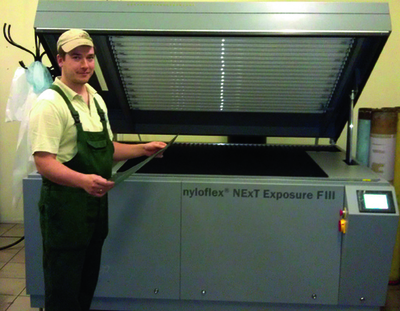 Conflex in Russia has installed a nyloflex NExT Exposure FIII unit from Flint Group
Conflex in Russia has installed a nyloflex NExT Exposure FIII unit from Flint Group
A partnership between Esko and PPP, in Manchester, is taking advantage of these advanced processing capabilities by using Full HD Flexo in the round with Equinox to achieve exceptional print results. In October 2012, Esko installed a CDI at PPP with a view to develop inline UV exposure technology for sleeves, with HD screening, CDI, Cantilever, and Equinox (fixed palette process printing with extended gamut).
Paul Bates said, ‘Although all these technologies are being used in flexo production in isolation today, this is a world first. It has taken a partner such as PPP with a vision to work with Esko and a number of select printers to bring this technology together. Collectively we have fine tuned the technology, developing new screening and exposure algorithms to make this staggering flexographic breakthrough.’
Process with water
Asahi Photoproducts offers a range of waterwash processors, including the AWP 1116 combination processor and dryer, which can reduce water consumption and improve environmental benefits significantly as it reuses the wash water and eliminates VOC emissions. The first UK installation of this machine is at YRG Group’s Stockport, Greater Manchester, site, as the reprographics specialist invests further in waterwash technology.
Tatsuya Tajima, managing director of Asahi Photoproducts in Brussels, approached YRG because of its reputation for leading the market with technology and its portfolio of FMCG customers. The two companies first started working together on the aqueous AWP platemaking equipment inAugust 2012.
Following the early success of label and flexible packaging print trials, YRG was keen to create a productive AWP centre of excellence within the group. The new machine has been in full production since September, giving the company increased production capacity with a format size of 60 x 42 inches.
The YRG Crossley Road Stockport site was selected to become the AWP technology centre, and the intention is to offer a trade service to printers throughout the entire UK with large format plates.
Although some printers in the UK market believe flat-top dot is the solution, Asahi and YRG said they believe that the AWP ‘Pinning Top Dot’ technology delivers significant benefits, such as consistency through on press stability and improved print contrast. Mark Gration, YRG Group managing director, commented, ‘Having done extensive trials on all flexo image carriers, YRG found that the printing advantages of AWP printing were the best.’
Flat-top dots
Flint Group’s nyloflex NExT exposure technology creates flat-top dots and can be incorporated into any digital platemaking workflow regardless of plate format and thickness.
The company is currently seeing much success with this solution in the Russian market with several installations at packaging printers.
Founded in June 2001, Conflex SPb serves the Russian market with flexible packaging and employs more than 250 people today. Customers include the largest food and FMCG producers in Russia as well as multinational players. The product portfolio varies from packaging for confectioneries, snacks, groceries, frozen goods, cosmetics and hygiene products, freeze-dried products to ice cream and dairy, as well as labels for PET bottles, and group packaging. In autumn 2012, the company decided to buy a nyloflex NExT exposure frame for its St Petersburg site to use in combination with the new nyloflex ACE printing plate.
 Screen showed the PlateRite FX1524 at Labelexpo
Screen showed the PlateRite FX1524 at Labelexpo
‘We can say that our quality in flexo printing is comparable to offset and gravure printing,’ stated Andrei Dmitrovich, head of the platemaking department. ‘Therefore our advertising slogan ‘We print the world! Try it and believe it!’ is verified by the quality of our packaging.’
The exposure technology produces improved highlights and fine vignettes and is globally established as flat-top technology. In flexible packaging, it enables an excellent ink transfer, particularly in the solids.
The LED-based exposure technology offers precise and reliable surface screening as well as the reproduction of the finest image details. In corrugated post-print, it shows not only an improvement in reproduction but also a significant reduction of the fluting effect.
In the plate
MacDermid’s thermal processing equipment Lava is available in three sizes for making plates up to 42 x 60 inches. Creating press ready plates in less than an hour, it integrates with most workflows, and eliminates solvents and VOCs from platemaking, resulting in a more environmentally friendly process.
Its well established Lux platemaking solution, which produces a digital plate with a unique dot profile from a 1:1 mask-to-plate plate imaging process, has now been built into the printing plate itself. The Lux ITP is designed to be processed using a standard digital workflow to create flattop dots. The company said that this technology is currently in alpha stage testing by a small group of leading converters. Although it is being used to produce commercial jobs today, further testing is planned prior to full commercial release.
The company recently took part in a collaboration to showcase current advancements in flexo printing. Mac-Dermid used its latest printing plate designed exclusively for UV inks in the narrow web market, the UVR, and applied a Lux Membrane 100 to the plate to create flat-top dots. The jobs were printed on an Omet Varyflex press at Clemson University, using Actega WIT inks and coatings, anilox rollers from Harper and doctor blades from Flexo Concepts.
Results were presented at Labelexpo in Brussels, and director of marketing, Heather Barrett, said, ‘Our new MacDermid UVR plate is designed to swell less with UV inks, while offering excellent print resolution and low dot gain. The project also incorporated the MacDermid Lux flat-top dot solution, which is widely accepted for flexible packaging and other difficult applications. The project for Labelexpo Europe 2013 involved difficult images and the results were outstanding!’
Boxing clever
DuPont’s Cyrel DigiCorr processing technology has seen recent success in the FlexoTech Awards where an entry from Saica Pack South took the top prize in the Corrugated Print category.
Printing with ‘hi-n’ plates produced by V&W Graphics in Louth, Lincolnshire, Saica impressed the judges with a box produced for Greene King Brewery. They said, ‘In a very close race, the winner was chosen for the excellent results achieved on a difficult substrate, without any noticeable loss of quality. This was a First Class job!’
The DigiCorr system was brought to market in 2008, developed to reduce issues of fluting when printing on corrugated board. By exposing the plates in an inert atmosphere, the dot profile is changed to make it more suitable for printing on this challenging type of substrate. This is achieved through an exposure unit modification that produces more precisely defined dots with a flat top and broad shoulders that will reduce dot gain and improve the ink laydown even on lower quality board. These ‘hybrid dot structures’ are created by removing the oxygen in the chamber and flooding the plate with pure nitrogen.
Up sizing
Xeikon introduced a new larger version in its range of ThermoFlexX digital imager at Labelexpo in Brussels. The ThermoFlexX 80 can process plates up to 1270 x 2032 mm in size, in thicknesses from 0.73 to 6.35 mm.
The machine has been evaluated by flexo expert, Tony White, who said, ‘The ThermoFlexX 80 offers a range of five resolutions 2400, 2540, 4000, 4800 and 5080 dpi. Any two from this range can be installed on current machines and automatically switched between by using ‘hot’ folders.
It currently has an output of about 4 sqm/hr, however, some very important speed developments will be introduced in the near future by using a dual head exposure system.
This will mean that it will be capable of a very impressive 12 sqm/hr output whilst maintaining the very high quality associated with this machine.’
In addition to speed and resolution, the ThermoFlexX 80 also includes features that provide additional flexibility and versatility for flexo pre-press customers. Mr White said, ‘The clamping design of the ThermoFlexX 80 allows plates to be mounted easily on to the drum, while a uniquely designed vacuum slider offers the flexibility to use plates of any width. The machine also features ergonomic plate mounting and its hybrid drum offers flexibility of holding plates in place either by vacuum or by magnetics.’
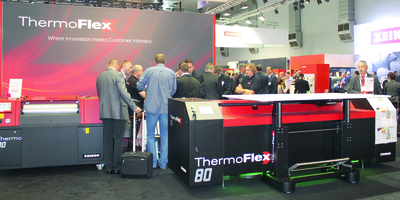 Xeikon launched the ThermoFlexX 80 at Labelexpo
Xeikon launched the ThermoFlexX 80 at Labelexpo
Screen
Another offering in thermal CtP systems comes from Screen Europe which has the PlateRite FX series for flexo and letterpress plates.
The latest model to be introduced is the PlateRite FX1200 which incorporates the company’s own thermal imaging technology, and features 4800 dpi resolution producing high quality gradients, uniform flat tints, fine text and solid line detail with smooth edges for all packaging applications. It has 64 channel laser diode imaging heads and optics producing 5 micron spot sizes and supports solvent, waterwash and thermally processed LAMs layer photopolymer plates up to 1200 x 1067 mm in size. An auto balance function accommodates different plate thicknesses and sizes, and the machine can be upgraded to the larger FX1524 specification of 1524 x 1067 mm if needed.
The company has just launched the Equios 2.0 hybrid workflow platform for its CtP systems to the UK market and will be engaging with its customers through a series of roadshows during November.

